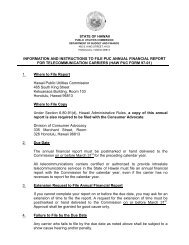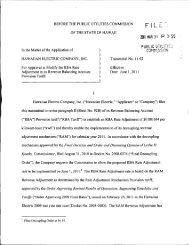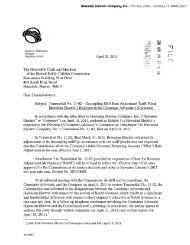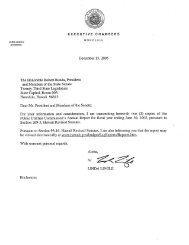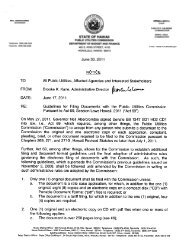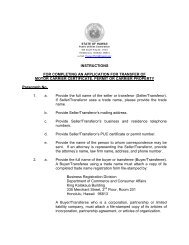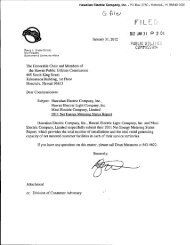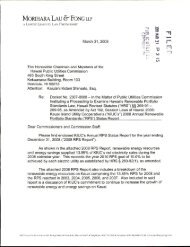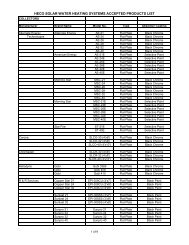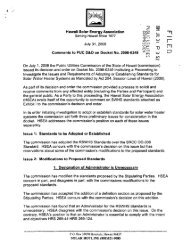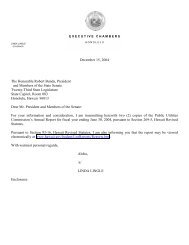PUC Annual ReportâFiscal Year 2011-12 - Public Utilities Commission
PUC Annual ReportâFiscal Year 2011-12 - Public Utilities Commission
PUC Annual ReportâFiscal Year 2011-12 - Public Utilities Commission
Create successful ePaper yourself
Turn your PDF publications into a flip-book with our unique Google optimized e-Paper software.
<strong>Public</strong> <strong>Utilities</strong> <strong>Commission</strong> <strong>Annual</strong> Report <strong>2011</strong>-<strong>12</strong><br />
State of Hawaii Page 70<br />
Utility Company Performance<br />
Fuel mix and RPS<br />
For a review of utility achievements to meet RPS goals, please see the<br />
Legislative Mandates section of this report.<br />
Electric <strong>Utilities</strong> Reliability and Service Quality<br />
The following electric utility service quality report was based on or excerpted<br />
directly from the <strong>2011</strong> Service Reliability Report submitted to the <strong>Commission</strong> by<br />
HECO, MECO, HELCO, and KIUC. The report covers the <strong>2011</strong> calendar year (“<strong>2011</strong>”).<br />
A complete copy is available for review at the <strong>Commission</strong>’s office or the <strong>Commission</strong>’s<br />
website (http://puc.hawaii.gov/industries/Energy/reports).<br />
The reliability indices are calculated using the data from all sustained 30 system<br />
outages except customer maintenance outages. If data normalization is required, it is<br />
done using the guidelines specified in the report on reliability that was prepared for the<br />
<strong>Public</strong> <strong>Utilities</strong> <strong>Commission</strong>, titled "Methodology for Determining Reliability Indices for<br />
HECO <strong>Utilities</strong>," dated December 1990. That report indicates that normalization is<br />
allowed for "abnormal" situations such as hurricanes, tsunamis, earthquakes, floods,<br />
catastrophic equipment failures, and single outages that cascade into a loss of load<br />
greater than ten percent of the system peak load. These normalizations are made in<br />
calculating the reliability indices because good engineering design takes into account<br />
safety, reliability, utility industry standards, and economics, and cannot always plan for<br />
catastrophic events.<br />
Indices measure reliability in terms of the overall availability of electrical service<br />
(ASA), the frequency or number of times a company customers experience an outage<br />
during the year (SAIF), the average length of time an interrupted customer is out of<br />
power (CAID), and the average length of time the company's customers are out of<br />
power during the year (SAID). SAID is an indication of overall system reliability<br />
because it is the product of SAIF and CAID and incorporates the impact of frequency<br />
and duration of outages on the company's total customer base.<br />
To determine the relative level of reliability, the statistics for four prior years,<br />
2007 through <strong>2011</strong>, are used for comparison.<br />
HECO Service Quality – Normalized Results<br />
This is the <strong>2011</strong> annual service reliability report of the Hawaiian Electric<br />
Company. The average number of electric customers increased from 295,637 in 2010<br />
to 296,679 in <strong>2011</strong> (a 0.23 percent increase). The <strong>2011</strong> peak demand for the system<br />
was 1,177 MW (evening peak), 23 MW lower than the peak demand in 2010; the<br />
highest system peak demand remains at 1,327 MW set on the evening of October <strong>12</strong>,<br />
2004.<br />
The annual service reliability for <strong>2011</strong> was the third best in the past five years in<br />
terms of all indices for all events. The reliability results for <strong>2011</strong> and four prior years are<br />
30 An interruption of electrical service of 1 minute or longer.



